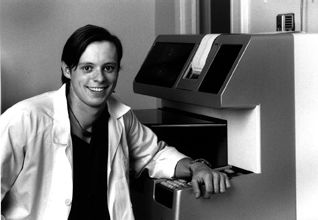Analytical chemist - Matthew Holdstock
Wine-making is a complex process that requires a combination of science and art. In simple terms, it is a fermentation process using a yeast organism to produce ethyl alcohol from the sugars in grape juice. The process produces around 400 different chemical compounds, many of which can react with each other and with any oxygen that might be present. Red wines are more complex than white because the grape skins are not removed before fermentation.
In Old World countries such as France, Germany and Italy, traditional methods are largely still held to be the key, and wine-makers practise their art with the help of centuries of experience and tradition. But in the New World, which includes Australia and the US, science has been pressed into service by wine-makers keen to unlock the secrets of wine production and ageing.
And when wine-makers want to know what is in a bottle of wine or the grapes they plan to use for the next vintage, they call on analytical chemists like me and my colleagues at the Australian Wine Research Institute in Adelaide.
We analyse grape juice and wine samples for sugar, alcohol, acids including those normally found in grapes, pH (overall level of acidity), sulphur dioxide (used as a preservative), and various spoilage compounds. We also measure 'volatile acidity', which is a quality wine- tasters like to argue about. Basically it is the result of bacteria converting tiny amounts of ethyl alcohol into acetic acid and ethyl acetate. All these factors influence wine quality and longevity, and some are subject to government regulation.
My work involves helping other scientists here to develop new and improved methods for analysing wine.
Equations and formulas may be hard work at times, but my advice is to stick with them because they can lead to exciting opportunities.

This work is reproduced from the Women in Science Enquiry Network
PO Box 647 Glebe 2037,
http://www.usyd.edu.au/wisenet
"Science Futures" was produced by Wisenet with the aid of a grant from the Department of Industry, Science and Tourism Science and Technology Awareness Program.